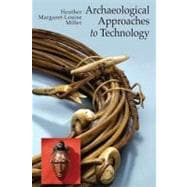
Note: Supplemental materials are not guaranteed with Rental or Used book purchases.
Purchase Benefits
What is included with this book?
| List of Figures | p. ix |
| Dedication | p. xiii |
| Preface and Acknowledgements | p. xv |
| Introduction: Archaeological Approaches to Technology | p. 1 |
| Terminology | p. 3 |
| Archaeology and Technology Studies | p. 7 |
| Overview of Volume | p. 9 |
| Methodology: Archaeological Approaches to the Study of Technology | p. 13 |
| Archaeological Field Techniques: Discovery/Recovery | p. 16 |
| Survey | p. 17 |
| Excavation | p. 19 |
| The Examination of Archaeological Remains | p. 21 |
| Simple Visual Examination and Measurement | p. 22 |
| Complex Examination of Physical Structure and Composition | p. 25 |
| Ordering and Analyzing Data | p. 27 |
| Reconstructing Production Processes; Chaîne Opératoire | p. 29 |
| Analogy and Sociocultural Interpretation | p. 30 |
| Experimental Archaeology | p. 34 |
| Ethnography, Ethnoarchaeology, and Historical Accounts | p. 36 |
| Extractive-Reductive Crafts | p. 41 |
| Classification of Crafts | p. 43 |
| Stone/Lithics | p. 46 |
| Collection and Preliminary Processing | p. 47 |
| Shaping and Finishing Methods | p. 54 |
| Knapping | p. 54 |
| Cutting (Sawing, Drilling, Groove-and-Snapping) | p. 57 |
| Pulverizing (Pecking) | p. 58 |
| Abrading (Grinding, Smoothing, Polishing, Drilling) | p. 59 |
| Production Stages | p. 59 |
| Organization of Production; Consumption | p. 61 |
| Fibers: Cordage, Basketry, Textiles | p. 65 |
| Collection and Preliminary Processing of Fibers | p. 68 |
| Production of Strands and Cordage | p. 72 |
| Fabric Production | p. 75 |
| Ornamentation and Joining | p. 81 |
| Organization of Production and Scheduling Demands | p. 85 |
| Wood, Bone, and Other Sculpted Organics (Antler, Horn, Ivory, Shell) | p. 89 |
| Collection and Preliminary Processing | p. 91 |
| Shaping and Finishing Methods | p. 94 |
| Organization of Production; Use and Reuse of Hard Organic Objects | p. 98 |
| Transformative Crafts | p. 101 |
| Fired Clay | p. 103 |
| Collection and Preliminary Processing; Formation of the Clay Body | p. 109 |
| Shaping Methods | p. 113 |
| Drying and Surface Treatments | p. 118 |
| Firing | p. 121 |
| Post-Firing Surface Treatments and Second Firings | p. 128 |
| Vitreous Silicates: Glazes, Faiences and Glass | p. 128 |
| Collection and Preliminary Processing | p. 130 |
| Creating the Vitreous Silicate Mixtures; Fritting; Melting of Glass (Glass Making) | p. 135 |
| Shaping of Faience and Glass Objects | p. 138 |
| Application of Glazes to Faience and Other Materials | p. 141 |
| Firing of Faience and Glazed Objects; Annealing of Glass | p. 143 |
| Post-Firing Surface Treatments | p. 144 |
| Metals: Copper and Iron | p. 144 |
| Collection, Including Mining | p. 147 |
| Processing of Ores and Native Copper; Fuel and Fluxes | p. 150 |
| Smelting | p. 152 |
| Refining and Alloying | p. 156 |
| Shaping and Finishing Methods: Casting and Fabrication (Including Forging) | p. 159 |
| Casting | p. 159 |
| Fabrication | p. 162 |
| Thematic Studies in Technology | p. 167 |
| Technological Systems; Reed Boat Production and Use | p. 168 |
| Reconstructing Reed Boats and Exchange Networks in the Arabian Sea | p. 169 |
| Reconstructing Reed and Plank Boats and Exchange Networks in Coastal Southern California | p. 173 |
| Innovation and the Organization of Labor | p. 180 |
| The Case of the Grain Harvesting Machine | p. 181 |
| Divisions of Labor, Women's Roles, Specialization, and Mass Production of Pottery | p. 185 |
| Technological Style | p. 191 |
| Style and Technological Style | p. 191 |
| Technological Traditions: Metal and Bone Working in North America | p. 195 |
| Thematic Studies in Technology (Continued) | p. 203 |
| Value, Status, and Social Relations: The Role of New Artificial Materials in the Indus Valley Tradition | p. 203 |
| Uses of Artificial Materials | p. 204 |
| Status Differentiation and the Development of Vitreous Materials | p. 206 |
| Determining Relative Value | p. 212 |
| Social Relations and the Relative Value of Indus Talc-Faience Materials | p. 217 |
| Artificial Materials and Cultural Value Systems | p. 225 |
| Technologies of Religious Ritual in the American Southwest | p. 226 |
| Religious Mural Construction, Use, and Discard | p. 228 |
| Archaeological Identification of Religious Ritual | p. 232 |
| The Analysis of Multiple Technologies | p. 237 |
| Cross-Craft Perspectives | p. 237 |
| Technological Style and Cross-Craft Interactions | p. 239 |
| Bibliography | p. 247 |
| Index | p. 283 |
| Table of Contents provided by Ingram. All Rights Reserved. |
The New copy of this book will include any supplemental materials advertised. Please check the title of the book to determine if it should include any access cards, study guides, lab manuals, CDs, etc.
The Used, Rental and eBook copies of this book are not guaranteed to include any supplemental materials. Typically, only the book itself is included. This is true even if the title states it includes any access cards, study guides, lab manuals, CDs, etc.